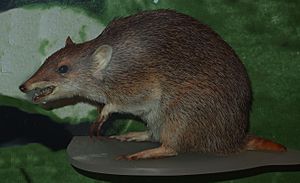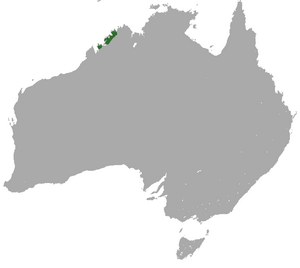Golden bandicoot facts for kids
Quick facts for kids Golden bandicoot |
|
|---|---|
 |
|
| Conservation status | |
| Scientific classification | |
| Genus: |
Isoodon
|
| Species: |
auratus
|
| Subspecies | |
|
|
 |
|
| Golden bandicoot range | |
The golden bandicoot (Isoodon auratus) is a small short-nosed bandicoot found in northern Australia. It is the smallest animal in its group, called a genus.
This bandicoot is now an endangered species. It used to live across much of northwestern Australia. It even lived near the border of New South Wales and South Australia. Today, it mostly lives in the Kimberley area of Western Australia. You can also find it on Augustus, Barrow, and Middle Islands. These islands are off the coast of Western Australia. Another group lives on Marchinbar Island in the Northern Territory. You can tell it apart from other brown bandicoots by its golden color and smaller size.
Contents
What the Golden Bandicoot Looks Like
The golden bandicoot is about 35 centimeters (14 inches) long from head to tail. It weighs between 260 and 655 grams (9–23 ounces). The average weight is about 310 grams (11 ounces). It is the smallest of the short-nosed bandicoots. Its back is golden, which is how it got its name. It has fine black streaks in its fur.
Its sides and face are a light, faded rust color. Its belly is a pale amber color. Its feet are the same color as its belly and have sharp claws. Like most bandicoots, it has a long, flat, pointy nose. The species was first described in 1897. This happened after a specimen was found near Derby, Western Australia.
How it Stays Cool
Golden bandicoots live in hot, dry places. They are very good at staying cool. They have a body temperature that changes often. This helps them deal with extreme heat without harm. They also have a low metabolic rate. This means their body produces less heat. They are also very good at saving water. They cool down by panting without losing much water. This is very important in dry environments.
Where Golden Bandicoots Live
In the 1930s, golden bandicoots were common across central Australia. By 1983, only a few groups remained on the mainland. These were in the Prince Regent National Park in the Kimberley region. Today, they live in good numbers on Barrow, Middle, and Augustus Islands. By 1995, they were also found in the Yampi Peninsula in northern Kimberley. Another group lives on Marchinbar Island in the Northern Territory.
Their Homes
The golden bandicoot lives in spinifex and tussock grasslands. They used to live in dry deserts and tropical forests. In Northern Kimberley, they live near rainforests with sandstone. In the Yampi Peninsula, they live in eucalypt woodlands. On Augustus and Marchinbar Islands, they live among sandstone in grasslands and woodlands. On Barrow and Middle Islands, they are found in grasslands and coastal shrubs. They disappeared from the deserts between the 1940s and 1960s.
How Many There Are
Each golden bandicoot uses an area of 12–35 hectares to live. The biggest group lives on Barrow Island, with about 20,000 bandicoots. It is the most common mammal on that island. On Middle Island, there are about 1,000 bandicoots. On Marchinbar Island, there are about 1,400. On mainland Australia, there are very few. Most of the population has disappeared from the mainland.
What Golden Bandicoots Eat and Do
The golden bandicoot is a omnivore. This means it eats both plants and animals. It eats succulents, insects, plant bulbs, and small reptiles.
Foraging and Daily Life
Golden bandicoots are nocturnal. This means they are active at night. During the day, they sleep in thick plants or hollow trees. They make nests from sticks, leaves, and grass. At night, they dig small, cone-shaped holes in the ground. They do this to find succulents, insects, and plant roots. Succulents are their main source of water. They have excellent eyesight for low light. Their sense of smell is also very good. This helps them find food when digging. If it gets too hot, they will burrow into the soil to stay cool.
Reproduction and Life Cycle
Golden bandicoots can have babies all year. They have more babies during the wet season (December-January) and the dry season (August). They have one of the fastest reproduction rates among marsupials. Their gestation period, which is how long the baby grows inside the mother, is only about 12 days. This is one of the shortest for any mammal.
They usually have 2–3 babies in each litter. The babies stay in the mother's pouch for up to 8 weeks. After this, the parents do not care for them much. This allows the golden bandicoot to have many babies quickly.
Threats to Golden Bandicoots
Many things have caused the number of golden bandicoots to drop. These include new animals brought to Australia, predators, and losing their homes.
Competition for Food
On Middle and Barrow Islands, black rats (Rattus rattus) were introduced. They competed with the golden bandicoots for food. This greatly reduced bandicoot numbers in the 1990s. But the black rats were removed from these islands in 1993. Since then, golden bandicoot numbers have grown five times larger. Rabbits also compete with them for resources.
Predators
Large birds are natural predators of the golden bandicoot. But many new predators have been brought into their areas. The European red fox (Vulpes vulpes), wild cats, and wild dogs all hunt golden bandicoots. When wild cats were brought to Hermite Island, the golden bandicoot quickly disappeared there before 1912. On Marchinbar Island, hair from golden bandicoots has been found in wild dog droppings. Aboriginal people have also hunted them.
Changes to Their Home
Changes in fire patterns are another big reason for the bandicoot's decline. Fires reduce the ground cover. This makes the golden bandicoot more open to predators. However, golden bandicoots seem to like areas that have burned recently. These areas often have fresh new plants growing close to the ground.
Helping Golden Bandicoots
A plan was made in 2003 to help the golden bandicoot and the golden-backed tree rat. This plan lasted for five years, from 2004 to 2009. It had three main goals:
- Work together with different groups and landowners.
- Create a team to help many species in northern Australia.
- Keep track of how many bandicoots there are.
- Move golden bandicoots from Marchinbar Island to two other islands. Then, check on these new groups.
- Find out what affects the weight of mammals in the tropical savannah.
- Create learning materials to share information.
- Involve the community in helping the bandicoots.
The Parks and Wildlife Service and the Gumurr Marthakal Rangers are working together. They check on existing groups of bandicoots. They also look for new groups and ways to move bandicoots to safe places.
See also
In Spanish: Bandicut dorado para niños


